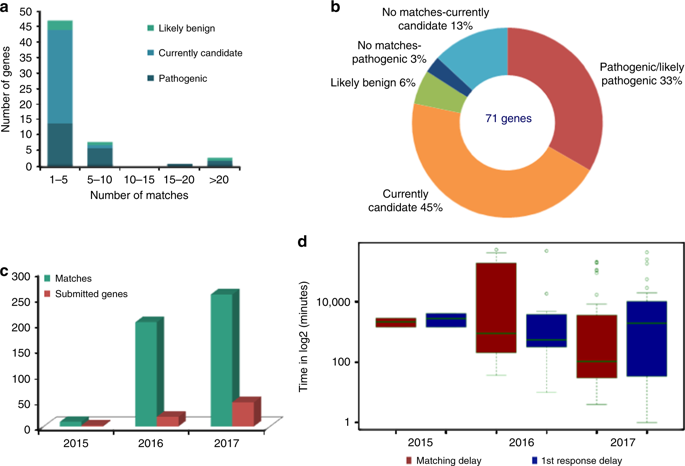当前位置:
X-MOL 学术
›
Genet. Med.
›
论文详情
Our official English website, www.x-mol.net, welcomes your
feedback! (Note: you will need to create a separate account there.)
2.5 years' experience of GeneMatcher data-sharing: a powerful tool for identifying new genes responsible for rare diseases.
Genetics in Medicine ( IF 6.6 ) Pub Date : 2018-12-19 , DOI: 10.1038/s41436-018-0383-z Ange-Line Bruel 1, 2 , Antonio Vitobello 1, 2 , Frédéric Tran Mau-Them 1, 2 , Sophie Nambot 1, 2, 3 , Yannis Duffourd 1, 2 , Virginie Quéré 1, 2 , Paul Kuentz 1 , Philippine Garret 1, 2, 4 , Julien Thevenon 1, 3 , Sébastien Moutton 1, 3 , Daphné Lehalle 1, 3 , Nolwenn Jean-Marçais 1, 3 , , Aurore Garde 1 , Julian Delanne 1 , Mathilde Lefebvre 1, 2 , François Lecoquierre 1, 2 , Detlef Trost 4 , Megan Cho 5 , Amber Begtrup 5 , Aida Telegrafi 5 , Pierre Vabres 1, 6 , Anne-Laure Mosca-Boidron 1, 2 , Patrick Callier 1, 2 , Christophe Philippe 1, 2 , Laurence Faivre 1, 3 , Christel Thauvin-Robinet 1, 2, 3, 7
Genetics in Medicine ( IF 6.6 ) Pub Date : 2018-12-19 , DOI: 10.1038/s41436-018-0383-z Ange-Line Bruel 1, 2 , Antonio Vitobello 1, 2 , Frédéric Tran Mau-Them 1, 2 , Sophie Nambot 1, 2, 3 , Yannis Duffourd 1, 2 , Virginie Quéré 1, 2 , Paul Kuentz 1 , Philippine Garret 1, 2, 4 , Julien Thevenon 1, 3 , Sébastien Moutton 1, 3 , Daphné Lehalle 1, 3 , Nolwenn Jean-Marçais 1, 3 , , Aurore Garde 1 , Julian Delanne 1 , Mathilde Lefebvre 1, 2 , François Lecoquierre 1, 2 , Detlef Trost 4 , Megan Cho 5 , Amber Begtrup 5 , Aida Telegrafi 5 , Pierre Vabres 1, 6 , Anne-Laure Mosca-Boidron 1, 2 , Patrick Callier 1, 2 , Christophe Philippe 1, 2 , Laurence Faivre 1, 3 , Christel Thauvin-Robinet 1, 2, 3, 7
Affiliation

|
PURPOSE
Exome sequencing (ES) powerfully identifies the molecular bases of heterogeneous conditions such as intellectual disability and/or multiple congenital anomalies (ID/MCA). Current ES analysis, combining diagnosis analysis restricted to disease-causing genes reported in OMIM database and subsequent research investigation extended to other genes, indicated causal and candidate genes around 40% and 10%. Nonconclusive results are frequent in such ultrarare conditions that recurrence and genotype-phenotype correlations are limited. International data-sharing permits the gathering of additional patients carrying variants in the same gene to draw definitive conclusions on their implication as disease causing. Several web-based tools have been developed and grouped in Matchmaker Exchange. In this study, we report our current experience as a regional center that has implemented ES as a first-line diagnostic test since 2013, working with a research laboratory devoted to disease gene identification.
METHODS
We used GeneMatcher over 2.5 years to share 71 novel candidate genes identified by ES.
RESULTS
Matches occurred in 60/71 candidate genes allowing to confirm the implication of 39% of matched genes as causal and to rule out 6% of them.
CONCLUSION
The introduction of user-friendly gene-matching tools, such as GeneMatcher, appeared to be an essential step for the rapid identification of novel disease genes responsible for ID/MCA.
中文翻译:

2.5 年 GeneMatcher 数据共享经验:识别罕见疾病新基因的强大工具。
目的 外显子组测序 (ES) 有力地识别异质性疾病的分子基础,例如智力障碍和/或多发性先天性异常 (ID/MCA)。目前的 ES 分析,结合仅限于 OMIM 数据库中报告的致病基因的诊断分析和随后扩展到其他基因的研究调查,表明致病基因和候选基因约占 40% 和 10%。在复发和基因型 - 表型相关性有限的此类极其罕见的情况下,经常会出现非结论性结果。国际数据共享允许收集更多携带同一基因变异的患者,以就其引起疾病的影响得出明确的结论。Matchmaker Exchange 中已经开发和分组了几个基于 Web 的工具。在这项研究中,我们报告了我们目前作为区域中心的经验,该中心自 2013 年以来一直将 ES 作为一线诊断测试,与致力于疾病基因鉴定的研究实验室合作。方法 我们使用 GeneMatcher 超过 2.5 年,共享 ES 鉴定的 71 个新候选基因。结果匹配发生在 60/71 个候选基因中,可以确认 39% 的匹配基因是因果关系并排除其中 6%。结论 引入用户友好的基因匹配工具,如 GeneMatcher,似乎是快速识别负责 ID/MCA 的新疾病基因的重要步骤。5年分享ES鉴定的71个新候选基因。结果匹配发生在 60/71 个候选基因中,可以确认 39% 的匹配基因是因果关系并排除其中 6%。结论 引入用户友好的基因匹配工具,如 GeneMatcher,似乎是快速识别负责 ID/MCA 的新疾病基因的重要步骤。5年分享ES鉴定的71个新候选基因。结果匹配发生在 60/71 个候选基因中,可以确认 39% 的匹配基因是因果关系并排除其中 6%。结论 引入用户友好的基因匹配工具,如 GeneMatcher,似乎是快速识别负责 ID/MCA 的新疾病基因的重要步骤。
更新日期:2019-01-26
中文翻译:

2.5 年 GeneMatcher 数据共享经验:识别罕见疾病新基因的强大工具。
目的 外显子组测序 (ES) 有力地识别异质性疾病的分子基础,例如智力障碍和/或多发性先天性异常 (ID/MCA)。目前的 ES 分析,结合仅限于 OMIM 数据库中报告的致病基因的诊断分析和随后扩展到其他基因的研究调查,表明致病基因和候选基因约占 40% 和 10%。在复发和基因型 - 表型相关性有限的此类极其罕见的情况下,经常会出现非结论性结果。国际数据共享允许收集更多携带同一基因变异的患者,以就其引起疾病的影响得出明确的结论。Matchmaker Exchange 中已经开发和分组了几个基于 Web 的工具。在这项研究中,我们报告了我们目前作为区域中心的经验,该中心自 2013 年以来一直将 ES 作为一线诊断测试,与致力于疾病基因鉴定的研究实验室合作。方法 我们使用 GeneMatcher 超过 2.5 年,共享 ES 鉴定的 71 个新候选基因。结果匹配发生在 60/71 个候选基因中,可以确认 39% 的匹配基因是因果关系并排除其中 6%。结论 引入用户友好的基因匹配工具,如 GeneMatcher,似乎是快速识别负责 ID/MCA 的新疾病基因的重要步骤。5年分享ES鉴定的71个新候选基因。结果匹配发生在 60/71 个候选基因中,可以确认 39% 的匹配基因是因果关系并排除其中 6%。结论 引入用户友好的基因匹配工具,如 GeneMatcher,似乎是快速识别负责 ID/MCA 的新疾病基因的重要步骤。5年分享ES鉴定的71个新候选基因。结果匹配发生在 60/71 个候选基因中,可以确认 39% 的匹配基因是因果关系并排除其中 6%。结论 引入用户友好的基因匹配工具,如 GeneMatcher,似乎是快速识别负责 ID/MCA 的新疾病基因的重要步骤。











































 京公网安备 11010802027423号
京公网安备 11010802027423号